![Samuel F.B. Morse [facsimile signature].](img-thumbnail/jpegs/56874.jpg)
Samuel F.B. Morse [facsimile signature]. Likesness from the last approved photograph from life.
Painted by Alonzo Chappel.
Johnson, Fry & Co Publishers, New York [1862].
Steel engraving. Sheet 270 x 195mm (10¾ x 7¾"). Trimmed.
Samuel Finley Breese Morse (1791-1872), American portrait painter and inventor, who contributed to the invention of a single-wire telegraph system and morse code with physicist Joseph Henry and mechanical engineer Alfred Vail.
[Ref: 56874] £140.00
(£168.00 incl.VAT)

Lindley Murray.
[n.d. c.1800].
Mixed-method, 4¼ x 2¾".
Lindley Murray (1745-1826), a Pennsylvania-born Quaker who, after a success law career, retired to York, England, for the sake of his health (1784). There, noticing a lack of suitable lesson-books for a Friends' school for girls, he wrote 'English Grammar Adapted to the Different Classes of Learners' (1795). Published both in England and America, running through nearly 50 editions and becoming the predominant grammar schoolbook. His 'English Reader' (1799) was described by Abraham Lincoln as 'the best schoolbook ever put in the hands of an American youth'.
[Ref: 259] £120.00
(£144.00 incl.VAT)
![[An manuscript promissory note with the autograph of Lindley Murray, Quaker grammarian]](img-thumbnail/jpegs/55319.jpg)
[An manuscript promissory note with the autograph of Lindley Murray, Quaker grammarian] Exch. £45 - Holdgate near York, 4th of 7th month, 1825. At sight, please pay to Wilson, Tweedy & Co., or their order, Forty five pounds, due to me from [old paper patch obscuring text] Lindley Murray.
Ink mss. promissory note. Sheet 85 x 190mm (3¼ x 7½"). Slightly trimmed, laid on album paper, old clipping pasted over edge, mounted on album paper with steel-engraved portrait with matching facsimile signature.
Lindley Murray (1745-1826), a Pennsylvania-born Quaker who, after a success law career, retired to Holdgate (near York, England) for the sake of his health (1784). There, noticing a lack of suitable lesson-books for a Friends' school for girls, he wrote 'English Grammar Adapted to the Different Classes of Learners' (1795). Published both in England and America, running through nearly 50 editions and becoming the predominant grammar schoolbook. His 'English Reader' (1799) was described by Abraham Lincoln as 'the best schoolbook ever put in the hands of an American youth'. Wilson, Tweedy & Co. were country bankers of High Ousegate, York.
[Ref: 55319] £190.00
(£228.00 incl.VAT)
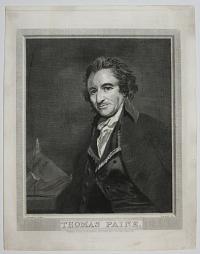
Thomas Paine.
Romney pinx. Sharp sc.
Published & Sold by E. Truelove, 240, Strand, three doors from Temple Bar.
Engraving. Plate: 300 x 230mm (11¾ x 9''). Trimmed within plate on lower edge. Messy in edges.
A portrait of Thomas Paine (1737-1809) who was an American political activist and Founding Father of the USA, at the start of the American Revolution he published two pamphlets which inspired the patriots to declare independence.
[Ref: 50031] £250.00
(£300.00 incl.VAT)

Elihu Palmer, Copied from the best Likeness that appeared in America. Tho' darkness drear obscured his visual ray, His mind, unclouded felt no loss of day: In Reason's cause his nervous thoughts combin'd Flow to the world, and harmonize mankind.
Engraved for & Published by R. Carlile, 84, Fleet St. London. [n.d., 1820s]
Stipple engraving. 135 x 200mm. Light foxing, mostly in margins. Glued to scrap sheet at 4 corners.
Elihu Palmer was an ex-Baptist minister who formed the 'Deistical Society of New York.' He wrote the 'Principles of Nature' in 1801. Eric R. Schlereth, 'Age of Infidelity: the politics of religious controversy in the early national United States', p. 84
[Ref: 1168] £80.00
(£96.00 incl.VAT)

William Penn.
Chapman sculp.
Engraved for the Encyclopedia Londinensis July 1823.
Engraving, with large margins; platemark 18 x 13cm (7 x 5").
William Penn (1644-1718), founder of Pennsylvania.
[Ref: 27193] £75.00
(£90.00 incl.VAT)
![[William Penn on the Banks of the Delaware.]](img-thumbnail/jpegs/49069.jpg)
[William Penn on the Banks of the Delaware.]
RS. [Robert Spence.]
[n.d., c.1905.]
Etching on vellum, signed in pencil. Plate: 345 x 445mm (13½ x 17½''). Creasing.
A scene showing William Penn and a group of Europeans standing before a group of Native Americans. By artist Robert Spence (1871-1964) who was a member of the Royal Society of Painter Printmakers.
[Ref: 49069] £180.00
(£216.00 incl.VAT)

William Penn.
Chapman sculp.
Engraved for the Encyclopedia Londinensis July 1823.
Engraving. 7 x 5".
[Ref: 1231] £45.00
(£54.00 incl.VAT)
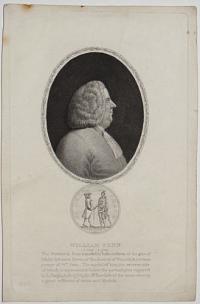
William Penn. b. 1644. d. 1718. The Portrait is from a model is basso relievo of the size of life by Sylvanus Bevan, of the Society of Friends, & a cotemporary of W.m Penn. The medal of him, the reverse side of which is represented below the portrait, was engrav'd by L. Pingo, A.D. 1770, for B.n Bartlett of the same society; a great collector of coins and medals.
[n.d., c.1800.]
Stipple. Plate: 200 x 120mm (8 x 5"). Small margins.
A bust portrait in an oval of founder of Pennsylvania and early Quaker William Penn (1644-1718).
[Ref: 45807] £120.00
(£144.00 incl.VAT)

William Penn. From the Original Picture painted for the Society for commemorating the landing of William Penn on the shores of the Delaware, October 1682.
Painted by H.Inman. [***] by J.Sartain.
[Publication line erased. n.d., c. 1860 ]
Colour mezzotint, later printing of Sartain's very rare engraving. 660 x 500mm. Some damage to edges, well outside image.
William Penn (1644-1718), Quaker and founder of Pennsylvania. Henry Inman (1801-46), American portrait painter. John Sartain (1808-1897), American engraver. Penn was born October 14, 1644 to Anglican parents, Admiral Sir William Penn and Margaret Jasper. For much of his young life he knocked about, getting expelled from Oxford, learning law at Lincoln's Inn, studying in the Huguenot Academy at Saumer, and managing his father's estates in Ireland. Soon after hearing the famous apostle Thomas Loe, he converted to Quakerism. Then in his mid twenties, he quickly involved himself in the Quaker cause, landing in prison several times for his 'radical' preaching for personal, property, and religious rights. In 1672 he married Gulielma Maria Springett, and five years later traveled in the company of George Fox to Holland. Penn, though wealthy and though a Quaker, lived beyond his means. In order to raise some funds he called in a debt owed his father by Charles II. On March 4, 1681 he obtained the charter for Pennsylvania, [and in August 1682 he gained the rights to Delaware from his friend James, the Duke of York.] Penn planned to make money by selling tracts of land, and although he was able to attract a good number of investors he never realized the profit he imagined. However, he saw this venture as more than a money-making exercise; it was, in his famous words to his friend and land agent for Pennsylvania, James Harrison, a "holy experiment." This experiment would become, as he confidently predicted, "the seed of a nation.". Penn imagined a "free. .sober and industrious people" living by their own laws. In 1682 he sought to delineate these laws in the First Frame of government; and though somewhat less liberal than his New Jersey bill, it provided many of the same rights. Penn first arrived at his new colony in the fall of 1682 and stayed only until August of 1684. It was at this time that he supposedly signed his famous treaty with the Delaware (Leni Lenape) at Shackamaxon. And though no copy of such an agreement exists, we do have a wampum belt allegedly given to Penn by the Indians. The first treaty document in existence is one dated July 15, 1682 in which Penn obtains land from Idquahon and several other Leni Lenape leaders. In the next year Penn would broker at least eight other land transactions with the Delaware. He was busy with man other tasks as well. During his first stay, Penn began building his mansion and attending to numerous details of colony building, including a border dispute with Lord Baltimore, who controlled the territory south of Pennsylvania. He returned to England to continue his dispute with Baltimore, not to return to Pennsylvania until 1699. The England in the 1690s was a tumultuous place, especially for an outspoken, liberal Quaker. Penn never shirked from the political fray, as did many of his fellow Quakers, though his forthrightness proved dangerous. He supported James II, though in the Glorious Revolution of 1688 William and Mary bested James. Later, under suspicion of treason, Penn briefly lost control of his colony from 1692 to 1694. He received another setback when his wife died in 1694, though he rebounded by remarrying a year and a half later to Hannah Callowhill. Back in Pennsylvania, political squabbling had set in and various leadership changes took place. In 1691 George Keith led a religious schism, and Pennsylvania and Delaware separated into two provinces. And in 1696, William Markham's (Penn's secretary and then governor of Delaware) charter replaced the earlier 'Frame', though when Penn returned in 1701 he would again revise this version. By the time he left for good in November of that year, the colony's Assembly was elected yearly and enjoyed a more powerful position than the governor, who despite his veto power, was secondary to the legislative body. Though Penn planned to stay in the New World, settling at his manor Pennsbury, (up the Delaware from Philadelphia) but further political troubles in England forced his return, and in 1712 suffered an attack of apoplexy which disabled him. His wife Hannah managed his affairs until Penn died in 1718, and after her death ion 1727 the proprietorship of Pennsylvania passed to their sons, John, Thomas, and Richard. Ex: Collection of The Hon. C. Lennox-Boyd.
[Ref: 3400] £240.00
(£288.00 incl.VAT)
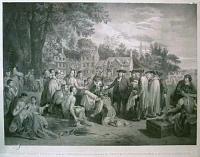
William Penn's Treaty with the Indians, when he founded the Province of Pensylvania in North America.
[after Benjamin West.]
[n.d., c.1840.]`
Lithograph, 13½ x 17".
Penn was born October 14, 1644 to Anglican parents, Admiral Sir William Penn and Margaret Jasper. For much of his young life he knocked about, getting expelled from Oxford, learning law at Lincoln's Inn, studying in the Huguenot Academy at Saumer, and managing his father's estates in Ireland. Soon after hearing the famous apostle Thomas Loe, he converted to Quakerism. Then in his mid twenties, he quickly involved himself in the Quaker cause, landing in prison several times for his 'radical' preaching for personal, property, and religious rights. In 1672 he married Gulielma Maria Springett, and five years later traveled in the company of George Fox to Holland. Penn, though wealthy and though a Quaker, lived beyond his means. In order to raise some funds he called in a debt owed his father by Charles II. On March 4, 1681 he obtained the charter for Pennsylvania, [and in August 1682 he gained the rights to Delaware from his friend James, the Duke of York.] Penn planned to make money by selling tracts of land, and although he was able to attract a good number of investors he never realized the profit he imagined. However, he saw this venture as more than a money-making exercise; it was, in his famous words to his friend and land agent for Pennsylvania, James Harrison, a "holy experiment." This experiment would become, as he confidently predicted, "the seed of a nation.". Penn imagined a "free. .sober and industrious people" living by their own laws. In 1682 he sought to delineate these laws in the First Frame of government; and though somewhat less liberal than his New Jersey bill, it provided many of the same rights. Penn first arrived at his new colony in the fall of 1682 and stayed only until August of 1684. It was at this time that he supposedly signed his famous treaty with the Delaware (Leni Lenape) at Shackamaxon. And though no copy of such an agreement exists, we do have a wampum belt allegedly given to Penn by the Indians. The first treaty document in existence is one dated July 15, 1682 in which Penn obtains land from Idquahon and several other Leni Lenape leaders. In the next year Penn would broker at least eight other land transactions with the Delaware. He was busy with man other tasks as well. During his first stay, Penn began building his mansion and attending to numerous details of colony building, including a border dispute with Lord Baltimore, who controlled the territory south of Pennsylvania. He returned to England to continue his dispute with Baltimore, not to return to Pennsylvania until 1699. The England in the 1690s was a tumultuous place, especially for an outspoken, liberal Quaker. Penn never shirked from the political fray, as did many of his fellow Quakers, though his forthrightness proved dangerous. He supported James II, though in the Glorious Revolution of 1688 William and Mary bested James. Later, under suspicion of treason, Penn briefly lost control of his colony from 1692 to 1694. He received another setback when his wife died in 1694, though he rebounded by remarrying a year and a half later to Hannah Callowhill. Back in Pennsylvania, political squabbling had set in and various leadership changes took place. In 1691 George Keith led a religious schism, and Pennsylvania and Delaware separated into two provinces. And in 1696, William Markham's (Penn's secretary and then governor of Delaware) charter replaced the earlier 'Frame', though when Penn returned in 1701 he would again revise this version. By the time he left for good in November of that year, the colony's Assembly was elected yearly and enjoyed a more powerful position than the governor, who despite his veto power, was secondary to the legislative body. Though Penn planned to stay in the New World, settling at his manor Pennsbury, (up the Delaware from Philadelphia) but further political troubles in England forced his return, and in 1712 suffered an attack of apoplexy which disabled him. His wife Hannah managed his affairs until Penn died in 1718, and after her death ion 1727 the proprietorship of Pennsylvania passed to their sons, John, Thomas, and Richard.
[Ref: 6523] £420.00

William Penn. European Magazine.
Stanier sculp.t.
Published by J. Sewell, Cornhill May 1. 1790.
Engraving and stipple. 190 x 130mm (8¾ x 4¾"), with wide margins.
Half-length portrait, with a roundel scene of Penn shaking hands with a native American, reresenting his treaty with them.
[Ref: 23131] £95.00
(£114.00 incl.VAT)
![Edgar Poe par H. Lefort. [in pencil to the right.]](img-thumbnail/jpegs/24000.jpg)
Edgar Poe par H. Lefort. [in pencil to the right.]
[After Samuel W. Hartshorn.]
[n.d. c.1849.] [In pencil to the right:] Avant toutes lettres.
A very scarce etching, proof before all letters. Plate 343 x 241mm. 13½ x 9½".
Edgar Allan Poe (1809-1849) was an American author, poet, editor and literary critic, considered part of the American Romantic movement; best known for his tales of mystery and macabre. Poe and his works influenced literature in the United States and around the world, as well as in specialised fields, such as cosmology and cryptography.
[Ref: 24000] £260.00
(£312.00 incl.VAT)
![Edgar A. Poe [facsimile signature.]](img-thumbnail/jpegs/40516.jpg)
Edgar A. Poe [facsimile signature.]
F.T. Stuart.
[n.d., c.1885.]
Steel engraving. 150 x 95mm (6 x 3¾"). Small margins.
Portrait of American author Edgar Allan Poe (1809-49), engraved by Frederick T. Stuart of Boston from a daguerreotype by William Abbott Pratt, taken in Richmond, Virginia, in 1849, only a few weeks before Poe’s death. It was first published as the frontispiece to George E. Woodberry’s biography of Poe, published 1885), with a signature copied from an 1844 letter, now in the Huntington Library.
[Ref: 40516] £75.00
(£90.00 incl.VAT)
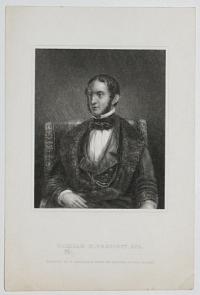
William H. Prescott, Esq.
Engraved by W. Greatbatch, from the Original Picture by Ames.
[n.d., c.1830.]
Engraving. Sheet: 170 x 115mm (7 x 5"). Trimmed.
A portrait of American historian William Hickling Prescott (1796-1859).
[Ref: 45805] £60.00
(£72.00 incl.VAT)
![[Stephen Price, Esq.re.]](img-thumbnail/jpegs/56395.jpg)
[Stephen Price, Esq.re.]
[S.W. Reynolds, Junr,, Pinxt. S.W. Reynolds, Sculpt. Engraver to the King.]
[Published by S.W. Reynolds, Bayswater.] [n.d., c.1826.]
Fine mezzotint, proof before all letters. 360 x 255mm (14¼ x 10"), with large margins. Plate uncleaned.
Stephen Price (1782-1840), American theatrical manager and impresario, seated with books behind. The portrait was drawn, engraved and published by Samuel William Reynolds, during Price's tenure as manager of the Theatre Royal, Drury Lane (1826-30). He used the position to encourage English stage stars to tour the US and appear in his own Park Theatre in New York. Whitman 242.
[Ref: 56395] £360.00

Colonel James Read. One of the Fathers of the American Navy.
Engraved by Samuel Sartain, Phila.
[Philadelphia, USA: S. Sartain, n.d., c.1870.]
Steel engraving, with large margins, image 135 x 100mm. 5¼ x 4". Some light marginal spotting and soiling.
Portrait of American soldier James Read (1743 - 1822), promoted from 1st lieutenant to colonel for gallant services at the battles of Trenton, Princeton, Brandywine, and Germantown during the American Revolutionary War. He was appointed one of the three commissioners of the navy for the middle states by Congress on 4 November, 1778, and on 11 January, 1781, was invested by the same body with sole power to conduct the navy board. Biography below title, and pasted below that a typescript cutting recording that the portrait was presented to Roland Bonaparte, Prince of Canino and Musignano (1858 – 1924) by a great-nephew of the sitter, one General Meredith Read. According to a pen inscription in French to verso, the gift was received in 1895. Samuel Sartain (1830 - 1906), engraver.
[Ref: 24422] £180.00
(£216.00 incl.VAT)

General Reed, Member of the Congress.
Drawn from the Life by Du Simetiere in Philadelphia. B. Reading sculp. [faint scratched letters underneath image].
Publish'd May 10th 1783 by Wm. Richardson 174 Strand.
Etching with stipple engraving. Sheet 153 x 135mm. Trimmed to plate.
Joseph Reed [1741 – 1785], American Revolutionary political leader and army officer. He studied law, was admitted (1763) to the bar, and then went to London to study at the Middle Temple. After returning (1765) to practice law in Trenton, he took an active part in pre-Revolutionary affairs. After settling (1770) in Philadelphia Reed became a member of the committee of correspondence (1774) and president of the Pennsylvania provincial congress (1775). In the war he served as military secretary to George Washington and as adjutant general and took part in a number of battles. He served in the Continental Congress (1777–78). As president (1778–81) of the supreme executive council of Pennsylvania he abolished slavery in Pennsylvania and caused (1778) Benedict Arnold to be prosecuted on charges of corrupt practices. He was a trustee and founder of the University of the State of Pennsylvania (later the University of Pennsylvania). Plate IV from 'American Legislators', Pierre Eugene du Simitiere opened a Natural history Museum in Philidelphia in 1782. his portraits of notable Americans and presidents are highly regarded. See Library of Congress: 146.
[Ref: 1912] £160.00
(£192.00 incl.VAT)
![[Theodore Roosevelt]](img-thumbnail/jpegs/43745.jpg)
[Theodore Roosevelt] Trial artist proof from Copper. finished state. Frederick Reynolds [in m.s. by artist]
Rare mezzotint on india. 365 x 260mm (14¼ x 10¼"), with very wide margins. Paper tone.
Portrait by American mezzotinter Frederick Reynolds (1924, fl.) of American President Theodore Roosevelt.
[Ref: 43745] £290.00
(£348.00 incl.VAT)

Colonel Tal. P. Shaffner, LL.D. &c. Projector of the North Atlantic Telegraph.
Engraved by D.J. Pound from a Photograph by Mayall.
[n.d., c.1860]
Engraved. Sheet: 270 x 170mm (11 x 7"). Trimmed.
A three-quater length portrait of Col. Taliaferro Preston Shaffner (1811-1881) an American inventor and entrepreneur who supported telegraphy when it was in its infancy.
[Ref: 45809] £65.00
(£78.00 incl.VAT)

Samuel Scott, the unfortunate American Diver.
[n.d., c.1841.]
Rare lithograph. Sheet 260 x 200mm (10¼ x 8"). Some slight surface soiling.
A portrait of Samuel Gilbert "Sam" Scott (c. 1813-41), an American daredevil, printed shortly after his deadly fall from Waterloo Bridge. Born in Philadelphia, Scott served in the U.S. Navy where he became well known for jumping off the masts of ships. This led to a career as a stuntman and daredevil, travelling the U.S. and Canada performing his death-defying leaps, including a purported 593-foot jump from Niagara Falls. On January 11, 1841, Scott planned to run from the White Lion Pub in Drury Lane to Waterloo Bridge, jump from a scaffold on the bridge into the river, and return to the pub during the hour between 1:00 and 2:00 P.M. As per previous bridge jumps, a rope attached to the scaffold allowed Scott to swing away from the bridge before diving. But on this jump, the rope wrapped around Scott's neck. The spectators erroneously thought that this was part of Scott's act, no immediate action was taken and Scott inadvertently hung himself. OCLC cites but one extant example in North Americana collections. A recorded example at the Wellcome Library includes a Day & Son stamp on verso of a mount.
[Ref: 49510] £290.00
(£348.00 incl.VAT)

Maj. Gen. W.m T. Sherman.
Max Rosenthal Del. Engr.d by L.N. Rosenthal, 327 Walnut St Philad.a
Published by William Smith, Printseller, No 702. South Third St. Phil:a. Entered according to act of Congress in the Year 1865 by W.m Smith, in the Clerk's Office of the District Court of the United States for the Eastern District of Pennsylvania.
Tinted lithograph. Printed area 670 x 480mm (26¼ x 19"), with large margins. Tears in edges, some slight spotting.
A head and shoulders portrait of Union General William Sherman within a triumphal border. Originally a frame maker, William Smith ran a print shop in Philadelphia from c.1860 to c.1891, specialising in lithographic portraits and historical scenes. He moved to 702 South Third Street in 1863.
[Ref: 59227] £260.00
(£312.00 incl.VAT)

The Portraictuer of Captayne Iohn Smith / Admirall of New England. There are the Lines that Shew thy Face but those That shew thy Grace and Glory, brighter bee Thy Faire-Discoueries and Fowle-Overthrowes Of Salvages, much Civilliz'd by thee Best Shew they Spirit and to it Glory Wyn: So, though art Brasse without-but Golde within.
[Simon van de Passe.]
[n.d. c.1680.]
Engraving. Sheet 150 x 95mm (5¾ x 3¾"). Trimmed within plate, damage in image at top, laid on album paper.
Captain John Smith (1580-1631), soldier and adventurer who led the 1606 expedition to Virginia from Blackwall. He was largely responsible for the establishment of a trading settlement at Jamestown. During his stay in Virginia his life was saved by the Indian Pocahontas.
[Ref: 59877] £110.00
(£132.00 incl.VAT)
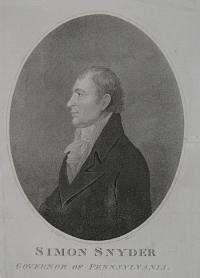
Simon Snyder Governor Of Pennsylvania.
W. Woolley Pinx. Tiebout sc.
Pub. by P. Price Philada [n.d., c.1808].
Stipple engraving with some etching, sheet 270 x 200mm. 10½ x 8". Tatty extremities, with small tears. Several horizontal creases.
Simon Snyder (1759 - 1819) was the governor of the Commonwealth of Pennsylvania from 1808 to 1817. A Jeffersonian Democrat, he served three terms as speaker of the Pennsylvania House of Representatives before becoming governor. He led the state through the War of 1812 and, following the conclusion of his term, was elected to the United States Senate, although he died in office in 1819.
[Ref: 9841] £75.00
(£90.00 incl.VAT)

Thos. Sully. 'Your grateful friend Thos Sully'
Drawn and Etch'd by H.B. Hall, n.y. 1869.
Etching. 125 x 165mm.
British-born American painter of portraits and historical scenes [1783 - 1872]. Printed on india paper in New York.
[Ref: 2920] £130.00
(£156.00 incl.VAT)

Major - General Zachary Taylor. President of the United States.
From an Original Daguerreotype. Engraved by John Sartain.
Entered according to Act of Congress in the year 1848, by Mess.rs Sartain & Sloanaker, in the Clerk's Office of the District Court for the Eastern District of Pennsylvania.
Mezzotint. 832 x 628mm. 32¾ x 24¾".
Full length portrait of Zachary Taylor, standing beside his horse and facing forward. Zachary Taylor (1784-1850) was the 12th President of the United States of America from 1849 to 1850 and was an American military leader. Taylor was the last President to hold slaves while in office. He was known as "old rough and ready" and had a forty-year military career in the United States, serving in the War of 1812, the Black Hawk War and the Second Seminole War.
[Ref: 23333] £220.00
(£264.00 incl.VAT)

John Tyler. President of the United States.
Painted by J.R. Lambdin. Engraved by J. Sartain.
Published by William Smith, No 702. So. 3.d St. Phil:a. Copyright Secured.
Mezzotint with facsimile signature. 620 x 430mm (24½ x 17"), with wide margins. Scuff in left border, nicks and spotting in edges.
A full length portrait of Tenth President John Tyler (1790-1862), painted while in office 1841-5. A Virginian slave-owner, he retired after his term of office, but re-entered politics in 1861, attempting to defuse the situation in the lead-up to the Civil War. However he felt his peace-efforts were being abused by the Federalists and eventually voted for the secession. In November 1861 he was elected to the Confederate House of Representatives but he died of a stroke before the first session. Originally a frame maker, William Smith ran a print shop in Philadelphia from c.1860 to c.1891, specialising in lithographic portraits and historical scenes. He moved to 702 South Third Street in 1863.
[Ref: 59229] £160.00
(£192.00 incl.VAT)
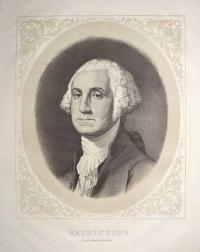
Washington.
[after Gilbert Stuart]
Published by Wm. Smith 702. So. Third St. Phil:a [n.d., c.1870].
Tinted lithograph. Printed area 540 x 400mm (21¼ x 15¾"), with large margins. Tears in edges, some slight spotting.
A head and shoulders portrait of George Washington within an oval, after the portrait by Gilbert Stuart. Originally a frame maker, William Smith ran a print shop in Philadelphia from c.1860 to c.1891, specialising in lithographic portraits and historical scenes. He moved to 702 South Third Street in 1863.
[Ref: 59226] £260.00
(£312.00 incl.VAT)

General Washington.
Engraved for the Encyclopedia Londonensis, 1828.
Stipple, watermark 1828, 160 x 110mm (6¼ x 4¼"), with very large margins.
Oval head and shoulders portrait of George Washington (1732-1799) in uniform, after Charles Gilbert Stuart.
[Ref: 62181] £130.00
(£156.00 incl.VAT)

Geo. Washington.
W. Grainger Sculp.t.
[Published as the Act directs Oct. 25, 1794 by H. D. Symonds Paternoster Row.]
Engraving. Sheet size: 210 x 130mm (8¼ x 5"), with small margins.
A bust portrait of American president George Washington (1732 - 1799). At the time of the portrait, Washington was President of the United States and as such is depicted in civilian dress.
[Ref: 35632] £120.00
(£144.00 incl.VAT)
![G. Washington [facsimile signature].](img-thumbnail/jpegs/59228.jpg)
G. Washington [facsimile signature].
Painted and Engraved by W.m E. Marshall, from the Original Cast from Life by Houdon, 1785.
Copyright 1878 by Oscar Marshall 245 Broadway, New York.
Lithograph with hand colour. Printed area 550 x 360mm (21¾ x 14¼"), very large margins.
A head and shoulders portrait of George Washington, said to be based on the statue of George Washington by the French sculptor Jean-Antoine Houdon (1741-1828), but more similar to the portrait by Gilbert Stuart.
[Ref: 59228] £260.00
(£312.00 incl.VAT)

General Washington. Parson's Genuine Edition of Hume's England.
[J.Parsons, Paternoster Row.][n.d., c.1793.]
Stipple. 140 x 85mm (5½ x 3¼''). Staining on right in title.
A profile portrait, set in an oval of American military commander and politician George Washington (1732-1799), who is considered one of the founding fathers of the United States of America and served as the first President from 1789-1797.
[Ref: 50916] £130.00
(£156.00 incl.VAT)

Geo. Washington.
[Grainger Sculp.t.]
[Published as the Act directs July 1. 1794 by H. D. Symonds Paternoster Row.]
Engraving. Sheet 180 x 105mm (7 x 4¼"). Trimmed, losing inscriptions, laid on album paper.
Portrait of George Washington as president, wearing a black coat and a jabot. Below the portrait is an unfurled scroll with a vague map on it, probably representing the site of the new capital. To the left of the scroll is a liberty pole and cap with a oak branch curling around it; to the right is a sword and set of scales.
[Ref: 51391] £70.00
(£84.00 incl.VAT)

Gen.l George Washington.
[London: Fielding & Walker, 1778.]
Scarce engraving. Sheet 165 x 110mm (6½ x 4¼"). Trimmed within plate for binding.
A half-length portrait of George Washington in uniform, within a decorative architectural frame. From William Russell's 'The History of America, from its Discovery by Columbus to the Conclusion of the Late War'. The title refers to the French-Indian War, when Washington was made a brevet brigadier general during the Forbes Expedition to capture Fort Duquesne.
[Ref: 57717] £140.00
(£168.00 incl.VAT)
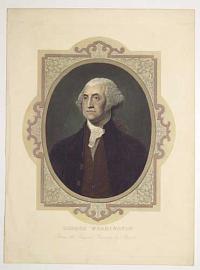
George Washington. From the Original Painting by Stuart.
[n.d. c.1850.]
Coloured steel engraving. 280 x 220mm (11 x 8¾"). Trimmed into plate at sides.
Oval head and shoulders portrait of George Washington (1732-1799) after Charles Gilbert Stuart.
[Ref: 60928] £65.00
(£78.00 incl.VAT)

Washington.
De Maurizio dis. Milano Lit. Corbetta.
[n.d., c.1850.]
Sepia tinted lithograph, sheet 440 x 305mm. 17¼ x 12". Sheet trimmed.
George Washington (1732 - 1799), printed in Milan, Italy, based on the 1796 portrait by Gilbert Stuart (1755 - 1828).
[Ref: 9929] £140.00
(£168.00 incl.VAT)
![[Walt Whitman]](img-thumbnail/jpegs/44289.jpg)
[Walt Whitman]
[Edward Gordon Craig.]
[n.d., c.1898.]
Woodcut. Printed area 125 x 95mm (5 x 3¾").
A chiaroscuro portrait American poet Walt Whitman (1819-1892) by Edward Gordon Craig, from 'The Page'. a monthly magazine published at the turn of the twentieth century.
[Ref: 44289] £160.00
(£192.00 incl.VAT)

Hough Williamson. M. D. LLD.
Trumbull, del. Thomson, sc.
Published by Henry Fisher, Caxton, London, 1823.
Stipple. Sheet size: 230 x 135mm. (9 x 5¼").
A portrait of Hugh Williamson (1735 - 1819), an American politician. He was best known for representing North Carolina at the Constitutional Convention. Williamson was a scholar of international renown. During the American Revolution, Williamson contributed his talents as physician and natural scientist to the American war effort. His experiences transformed the genial scholar into a politician and a determined leader in the campaign for effective national government. This leadership was evident not only at the Convention in Philadelphia but also, with telling effect, during the ratification debates in North Carolina. Wellcome: 3192
[Ref: 31686] £60.00
(£72.00 incl.VAT)

President Wilson.
Copyright. Pulished by S. Hildescheimer & Co. Ltd. London & Manchester. [n.d. c.1920.]
Photogravure with large margins. Plate 306 x 222mm.12 x 8¾".
Thomas Woodrow Wilson (1856-1924) the 28th President of the United States from 1913 to 1921. Upon taking office he set about instituting the reforms he had outlined in his book The New Freedom, including the changing of the tariff, the revising of the banking system, the checking of monopolies and fraudulent advertising, the prohibiting of unfair business practices, and the like. In the early days of World War I, Wilson was determined to maintain neutrality. He protested British as well as German acts; he offered mediation to both sides but was rebuffed. However, in 1917 the issue of freedom of the seas compelled a decisive change, and after four American ships had been sunk, he decided to ask for a declaration of war, and on April 6 the Congress granted it.
[Ref: 26919] £130.00
(£156.00 incl.VAT)
![Samuel F.B. Morse [facsimile signature].](img-thumbnail/jpegs/56874.jpg)

![[An manuscript promissory note with the autograph of Lindley Murray, Quaker grammarian]](img-thumbnail/jpegs/55319.jpg)



![[William Penn on the Banks of the Delaware.]](img-thumbnail/jpegs/49069.jpg)





![Edgar Poe par H. Lefort. [in pencil to the right.]](img-thumbnail/jpegs/24000.jpg)
![Edgar A. Poe [facsimile signature.]](img-thumbnail/jpegs/40516.jpg)

![[Stephen Price, Esq.re.]](img-thumbnail/jpegs/56395.jpg)


![[Theodore Roosevelt]](img-thumbnail/jpegs/43745.jpg)











![G. Washington [facsimile signature].](img-thumbnail/jpegs/59228.jpg)





![[Walt Whitman]](img-thumbnail/jpegs/44289.jpg)

